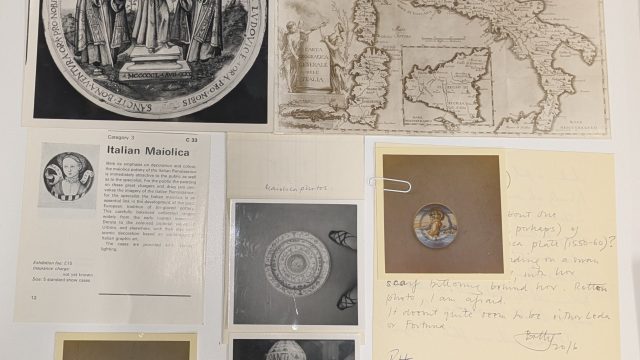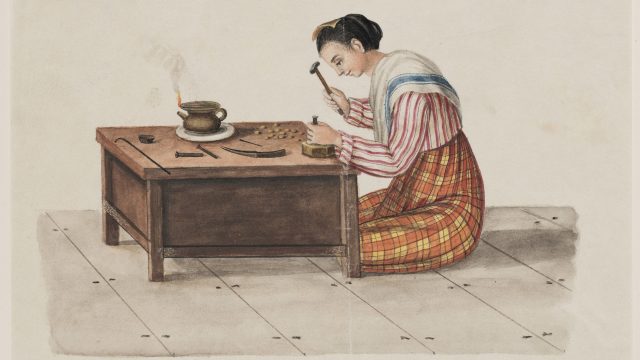Since 1984, Blythe House in Olympia, West London has been home to reserve collections, archives, laboratories, conservation studios and offices for three national museums: the British Museum, the Science Museum, and the Victoria and Albert Museum (Figure 1). The archives, stores and, since 2013, the Clothworkers Centre for the Study and Conservation of Textiles and Fashion can all be visited by appointment. In 2015, the Government announced that it would help to fund new storage facilities for the museums in order to vacate Blythe House. Since then, the V&A has embarked on a major project to ensure that over 250,000 objects, 1,000 archival collections and 350,000 library books will be ready to move to the new Collection and Research Centre in Stratford, East London.
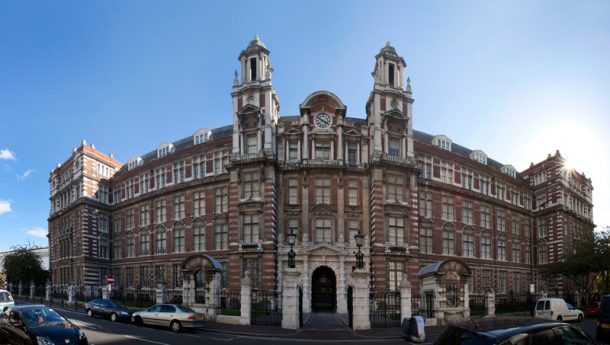
The V&A’s objects stored in this Edwardian building are extremely diverse, belonging to its collections of fashion, textiles, furniture, theatre and performance, metalwork, ceramics, glass, sculpture, architecture, paintings, and prints and drawings. A team of conservators in all the relevant disciplines has been recruited to ensure that all objects and archives are ready for the move. This article will focus on the paintings.
The paintings in the Blythe House stores number around 1600. The collection is extremely varied and spans 2000 years, from fragments of Roman fresco to contemporary Asian paintings. The majority, however, are sixteenth- to nineteenth-century European easel paintings depicting religious themes, landscapes, still lives, portraits or petit genre, and illustrations of literary works (Figure 2).
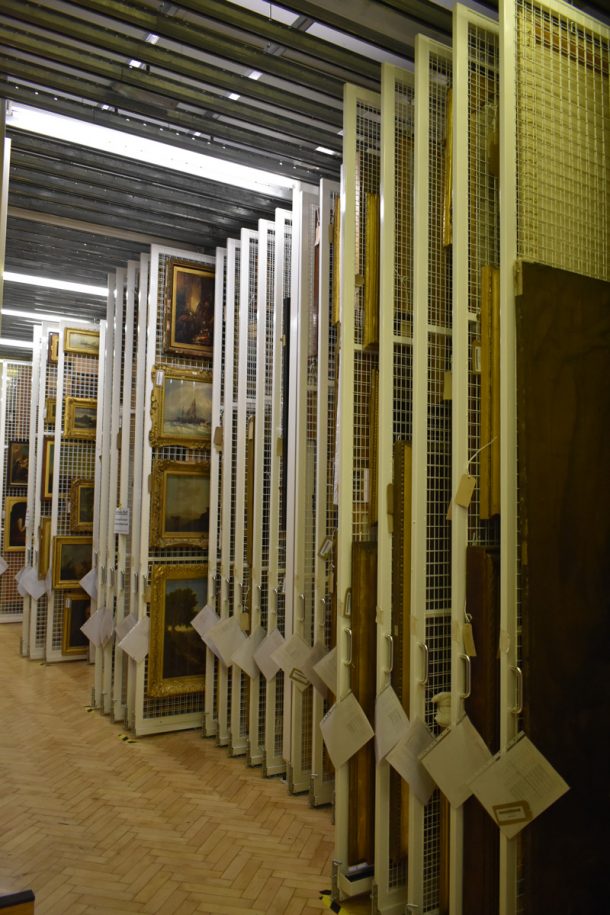
A condition survey of the paintings was carried out and it was determined that over 200 paintings needed intervention before the move. The issues that were identified included:
- Tenting or flaking that could lead to ground and paint being lost
- Recent paint losses
- Splits in wooden panels
- Canvas deformations (these could be a sign of tacking edges failing, debris behind the stretcher or insufficient tension)
- Tears or holes in canvases
- Paintings without protection on the reverse (backings protect paintings from accidental damage, dirt and humidity)
- Paintings poorly fitted in their frames
The work to be carried out could be divided into three main categories:
- Improvement of the framing
- Treatment of painting supports
- Treatment of ground and paint layers
Frames provide important protection to paintings, particularly when they are glazed and have a backboard. Where there is no backboard, this is frequently because the painting is deeper than the frame. Unfortunately, we do not have the resources within the current project to provide rigid backings as many frames would need additional joinery before a backboard could be fitted. Instead, ALU-PV fabric is stapled to the reverse of the frame and then sealed with gummed tape. We made one or two exceptions to this rule where a painting was particularly vulnerable and the frame also required remedial work.
Lee Emment, a Museum Technician practised in conservation framing, is carrying out this work, refitting paintings in their frames after treatment or if the framing is too loose or too tight. Panels change shape in response to changes in the moisture content of the air; if they are tightly framed, the resulting tension can cause the wood to split. Fixings are placed and adjusted with an eye to the possible warp so that a change in the panel dimensions can be accommodated while ensuring the panel is secure. Felt tape in the frame rebate protects the paint surface while spacers ensure that the painting cannot slip sideways. Such simple measures are very effective in preventing damage.
Treatments being carried out on canvas supports include:
- mending tears
- inserting fabric into holes in canvases
- reinforcing tacking edges
- reattaching canvases or lining canvases to stretchers or strainers
- strip lining
- improving tension
- removing planar deformations
- removing debris pushing canvases out of plane
- removing dirt from the reverse
- constructing padded backings for unlined canvases and those on strainers that cannot be expanded
We have found that unlined paintings without backings are generally the ones in the most fragile condition. The canvas is more brittle and has more planar deformations. Exposure to dirt on the reverse has helped to weaken the canvas which in turn has led to problems of adhesion for the ground and paint layers. Particles of surface dirt attract minute water droplets that can become acidic as carbon dioxide dissolves in them; this is one way in which dirt on the reverse of canvases speeds the degradation of the canvas fibres.
Problems such as weak tacking edges and large losses of the canvas support usually require long and complex treatments. In some cases, we have employed less time-consuming remedies inspired by paper conservation techniques such as applying Japanese Kozo paper strips to failing tacking edges using wheat starch paste as an adhesive. This secures the canvases so that they can be moved safely.
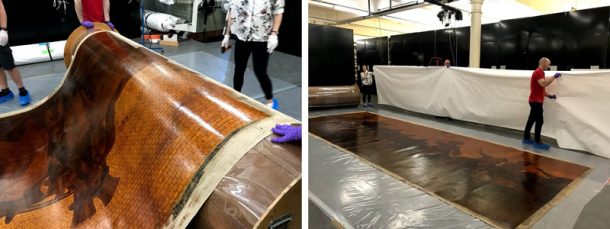
A key goal for the collection move is to ensure that every object has an image. Old English Merrymaking by J. M. Boekbinder (S.845-1997) was rescued from the proscenium arch of the Metropolitan Music Hall, Edgware Road before the building was demolished. With help from the technicians, we unrolled the painting for photography which gave us an opportunity to check its condition (Figure 3).
Stretcher bar linings are being applied to canvases without back protection; they are the most vulnerable, particularly if they do not have a frame. Stretcher bar lining is a technique devised at Tate that consists of a polyester sailcloth backing being fed beneath cross bars and attached to the reverse of the stretcher to provide protection. It creates an air cushion which substantially reduces vibration as well as keeping the reverse clean (Figure 4). Backings were attached to the majority of paintings in the V&A collection on acquisition; a policy which has been very beneficial.
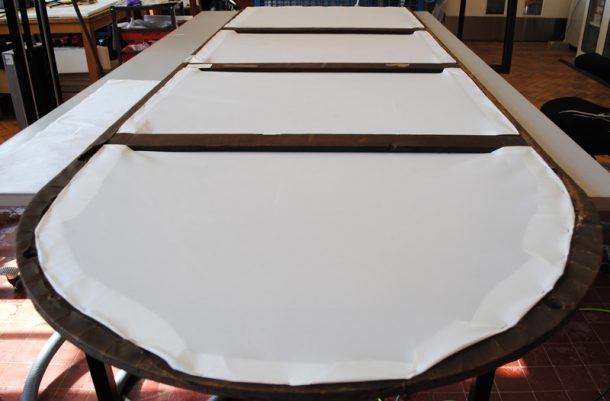
Framed paintings with fragile unlined canvases, and no cross-members to their stretchers, are being fitted with padded inserts. Polyester wadding fills the gaps between the reverse of the canvas and the backboard, to which it is attached. It provides support by slight contact with the reverse of the canvas and helps prevent movement.
Stretchers and strainers are being checked: splits in the wood are being repaired and wedges replaced and secured when they are missing or loose. Over the years many wedges have come loose from their stretchers, some being lost or falling behind stretcher bars, where they cause bulges in the canvas and eventually paint loss.
Work on panel supports involved consolidating areas on a few panels that were fragile due to earlier insect damage, repairing some splits; and filling losses that made the support vulnerable. As well as the familiar supports of canvas and wooden panel, we are also treating paintings on paper, copper and glass.
A key objective of the conservation work is to secure any loose ground and paint. Different adhesives are used for different problems. Flaking of ground and paint layers is often caused by movement in the support, whether this is mechanical, a knock or puncture, or environmental, through damp or cycles of damp and dryness (Figure 5). Sometimes both combine, for example where a canvas has been over-tensioned and diagonal cracks have formed across the corner. As the canvas loses strength, the paint curls and becomes almost corrugated. It demonstrates how careful we must be with tension since being too taut or too slack can be equally damaging.
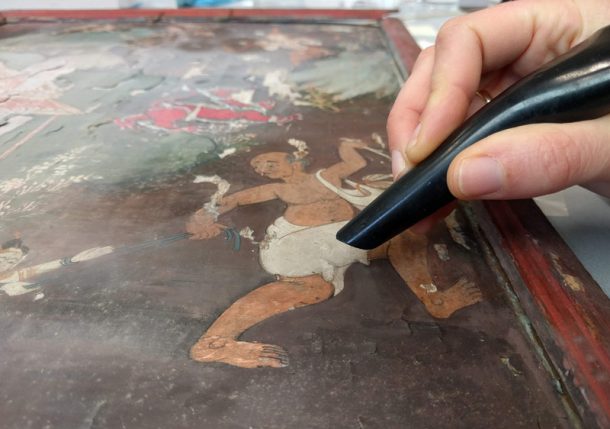
Another finding of interest concerns the application of a facing on paintings’ surfaces to hold vulnerable paint in place. Some of the works in store were treated as long as thirty years ago using a paper facing with sturgeon glue. It is recognised that the collagen in sturgeon glue (or any animal glue) becomes more brittle and less soluble with age. Removing these pieces of facing has proved very difficult in some cases and we have learnt from this that it is not a good idea for facing to be left on a paint surface for years. Undoubtedly, it was expected to be a temporary remedial measure when it was applied (Figure 6).
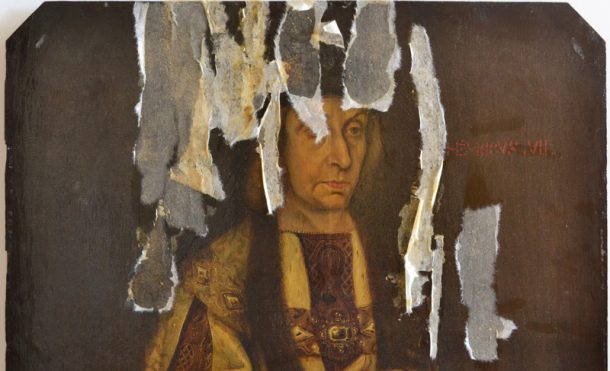
Paintings with ornate frames will travel in carry-frames while multiple similar-sized frames can be more densely packed in a slotted case. The few unframed paintings will go into slim carry-frames and remain in them on their new pull-out racks.
In a project of this scale, the planning of all the different stages and coordination of the different teams involved is crucial for success. At the time of writing this article, October 2019, we have completed conservation work on about 150 paintings and these are now ready for packing. My colleague Cerys Fry is continuing the work and we are on track to complete the work in summer 2020 in good time for the move. We know that these small treatments and preventive measures are important for the long-term preservation of the paintings and are grateful that the Blythe House Collections Move project has given us the opportunity to focus on the reserve collection.
